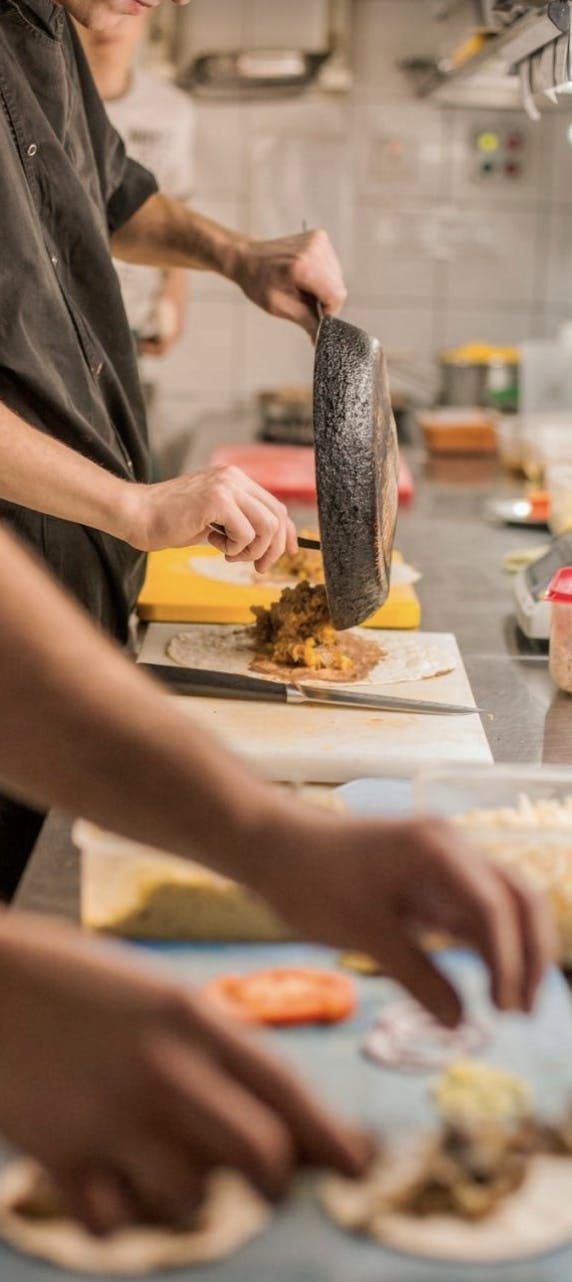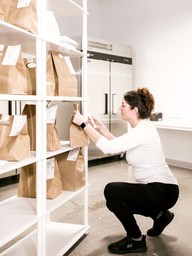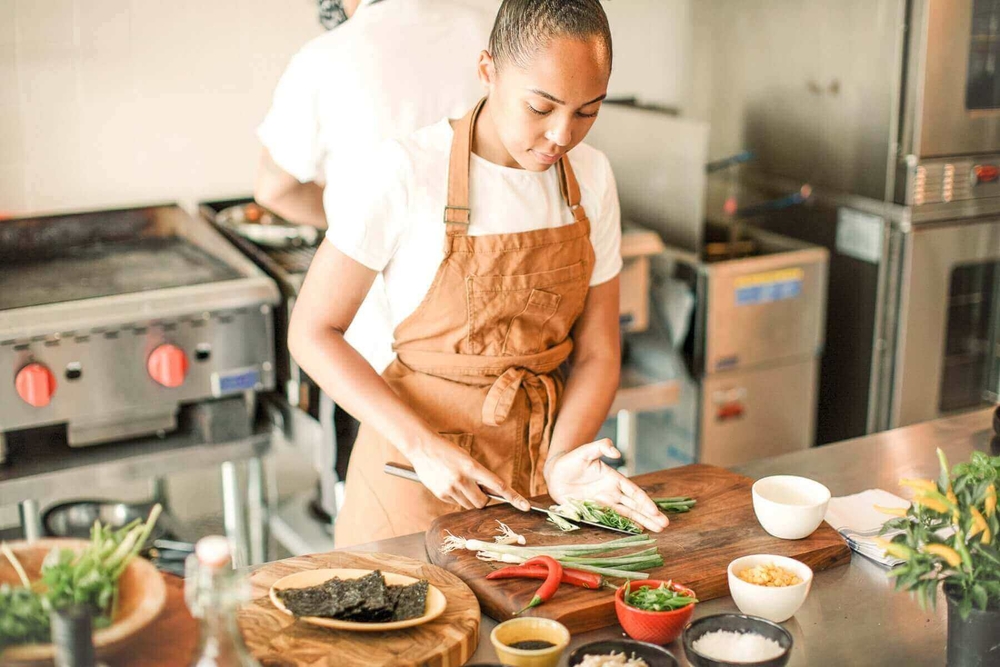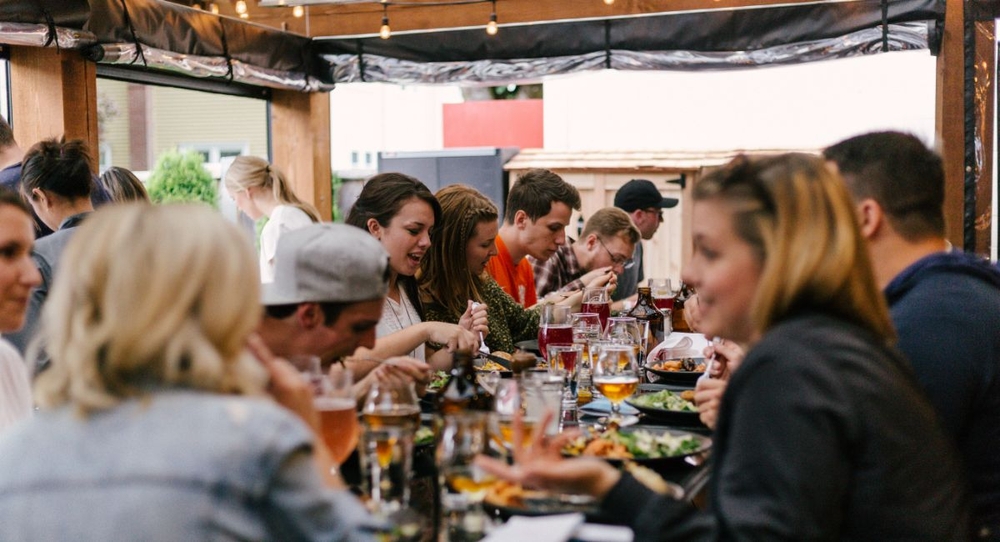Overcoming Food Delivery Challenges: Strategies for Success
Table of Contents
CloudKitchens
How many tacos can be delivered from a 1000sqft restaurant?
The same amount as a 200sqft ghost kitchen.

Once upon a time, enjoying a meal from your favorite restaurant was a night-long event. You had to make a reservation, curate the perfect outfit, and drive to the physical location before you could even begin enjoying the restaurant’s delicious food.
But those days are gone. Nowadays, enjoying your favorite dinner is as easy as opening an app, making a selection, and submitting your order. From there, it’s like magic—food straight from the oven, or in other words, straight from a ghost kitchen, is delivered to your door in no time.
This is great for customers, but for restaurateurs and others who work in the food service industry, the rise of home food delivery presents an array of challenges, particularly regarding the logistics of food delivery and meeting consumer demand.
Modern challenges in restaurant delivery & food delivery
As a restaurant owner, food delivery logistics involves customer service, food preparation, and managing delivery time windows. That’s what makes it such a complicated endeavor. However, identifying the common challenges that are inherent to your business can:
- Help you avoid costly mistakes
- Anticipate problems areas
- Streamline and optimize your restaurant operations
If you’re curious about the various challenges inherent to the logistics of food delivery, you’ve come to the right place. Keep reading to discover all you need to know about the most common challenges that come with food delivery and how to overcome them.
1. Delivery expectations
One of the biggest challenges that restaurants face with food delivery logistics is managing customer expectations. When they go out to eat, customers expect a bit of waiting, whether it’s for a table to open up, for their meal to be prepared, or for the waiter to bring the check. It’s all part of the process and is built into the experience.
But part of the appeal of ordering delivery is the convenience and speed it offers. Customers don’t want to wait for long periods to have their food delivered. They also want to know, as precisely as possible, when their meal is scheduled to arrive. These days, customers expect things like:
- Precise delivery windows
- Quick delivery
- Real-time order tracking
The responsibility to keep up with demand and uphold these time windows falls on the restaurant.
2. Quality control issues
At the end of the day, customers not only want their meal to arrive quickly—they want it hot and delicious when it gets there.
Understandably, making sure that every meal gets from your kitchen to the customer’s front door in restaurant-quality condition is no small task. It’s complicated by details like:
Order and time management – You need a system that allows you to process, track, prepare, and manage the delivery of multiple incoming orders. The ability to handle large volumes of orders without sacrificing quality is a crucial aspect of food delivery logistics.
- Packaging: How the food is packaged for delivery not only affects the quality but could become a food safety issue. Soggy or cold meals and leaking packages are all possible pitfalls and may avert customers away from your business. The same goes for delivering frozen food products without adequate cold storage.
- Accuracy: Each order passes through a number of different pairs of hands before finally making it to the customer. From the cooks who make it to the person who packages it to the driver who delivers it, the process is riddled with opportunities for mistakes.
3. Route planning
Planning the most efficient delivery routes for delivering food is a key factor in food delivery logistics. No matter how competent your kitchen, is or how customer-centric your ordering interface is, if you don’t have a comprehensive route planning system, your dreams of getting hot food to hungry customers are effectively dead on arrival. Timely delivery and customer satisfaction go hand-in-hand.
A satisfactory route-planning system is one that:
- Uses the best routes: It’s imperative that you find the routes that allow your delivery driver to make the most deliveries in the least amount of time, especially on those busy weekend evenings.
- Optimizes delivery: In addition to allowing you to make more deliveries faster, the best planning system allows you to do those things using the fewest resources possible.
4. Customer service
Just because food delivery minimizes the number of face-to-face interactions between you and your customers doesn’t mean that providing excellent customer service shouldn’t remain a top priority. When your delivery customers enjoy all the service perks of dining in, they’re more likely to become repeat clients.
When it comes to food delivery, putting the customer first includes:
- Offering a customer-centric approach: Offering delivery windows, convenient payment options, and accurate delivery notifications are all ways you can wow your customers with a convenient delivery experience.
- Communication: For customers, communicating with the restaurant is one of the greatest frustrations of placing an online order for food delivery. This is especially true if you use a third-party order management system. That’s why it’s imperative to have a system for communicating between your restaurant and your customers by phone or by text message.
5. Competition
If you’re in the restaurant business, you know that competition is the name of the game. And with so many restaurants playing, from local operations to large chains, the stakes are higher than ever.
With so many cooks in the kitchen, being a competitive player can be difficult. Some of the challenges that restaurants face include:
- Fickle customers: Every restaurant has its band of regulars—those loyal foodies who come in multiple times a month for your service and ambiance. But for deliveries, customers are more interested in things like deals, promotions, and rewards programs, which can lead them to shop around rather than become loyal customers.
- Competition from larger brands: For smaller operations, competing with national brands can be difficult. Small or local restaurants don’t have the built-in consumer trust of some larger brands, nor the resources to funnel into ambitious advertising or state-of-the-art technology.
Read more: Ghost Kitchen vs. Traditional Restaurant: Which Is Better?
Overcoming challenges with modern food delivery software
Although modern restaurants face a host of challenges when it comes to food delivery logistics, food delivery software systems are effective tools for managing those challenges and becoming competitive market players.
Food delivery software systems provide a number of benefits for restaurants, such as:
- Easier scalability: Food delivery systems make it easier for restaurants to handle a larger volume of deliveries at a time by assisting with order management, delivery routing, and order tracking. Additionally, these systems help you outsource certain delivery tasks and reap the benefits of hiring third-party food delivery services, which can save money, increase restaurant sales, and boost your profits.
- Improved customer experience: From real-time order tracking to storing personal information for easier ordering, food delivery software helps restaurants provide a customer-first experience through every step of the order process.
- Delivery route optimization: The capabilities for planning routes in real-time allow you to anticipate unexpected events like road closures or slowdowns and adjust routes accordingly. These technologies also search for the most efficient routes so that you can fully optimize every second of your delivery times.
Must-have features of food delivery logistics software
Not all food delivery systems are created equal. And, as more and more brands flood the market, knowing which features are must-haves can help you choose the software that’s best for your restaurant.
To that end, here are a few food delivery software must-haves:
- Accurate delivery estimates: The ability to provide customers with an accurate delivery time is crucial to providing excellent customer service and attracting repeat business. The best food delivery software should help you estimate delivery windows with precision.
- Automatic scheduling: Any food delivery software worth its salt is going to automatically assign orders to the most immediately available delivery person. However the best programs can factor in data delivery proximity and completion time, thus optimizing your delivery flow even more.
- Real-time dynamic routing: No food delivery system is complete without algorithmically based real-time routing. This feature finds the most efficient routes for your delivery drivers and adjusts them in real-time to respond to road conditions.
- Multi-drop delivery: Handling multiple deliveries during a single trip just makes sense—it saves restaurants time, money, and manpower. For that reason, you need a software system that can keep track of multiple deliveries along one route.
- Online chat: As we mentioned above, having a quick and reliable way for customers to communicate with the third-party delivery service is a necessary aspect of good customer service. To that end, you should look for software that provides online chat options for customers to directly communicate questions or complaints. This can also help you track and resolve ongoing issues.
Optimize your deliveries with CloudKitchens
In an age where ordering in is the new eating out, managing the logistics of food delivery has never been more important for restaurants. But figuring it all out can be a bit like trying to make a recipe with only half of the ingredients.
Fortunately, when you partner with CloudKitchens to set up a ghost kitchen in Philadelphia or whichever city you choose, we bring our own ingredients: skill, expertise, and innovation. Starting a ghost kitchen has never been easier.
At CloudKitchens, we’re reshaping the meaning of ghost kitchens and reimagining the restaurant industry by prioritizing seamless deliveries, minimizing costs, and maximizing profits. Our software for ghost kitchens does it all, including organizing your online orders, connecting each of your delivery platforms, and managing every aspect of your restaurant business. It’s the future of restaurant delivery, and we can take you there.
Read more:
- The Best Guide for Proper Food Delivery Packaging
- Best Practices for Optimizing Online Food Delivery Apps
- Mastering demand management: Strategies for handling peak delivery periods
- How to Gear Up Your Delivery Business for the Big Game
- Discover what are the top takeout food options to satisfy every craving
- Top 5 Food Delivery Apps for Your Restaurant
Explore ghost kitchen locations across the US:
- Ghost kitchens in San Francisco
- Ghost kitchens in LA
- Ghost kitchens in NYC
- Ghost Kitchens in Toronto
- Ghost Kitchens in Atlanta
- Ghost Kitchens in Dallas
- Ghost Kitchens in Chicago
- Ghost Kitchens in Denver
- Ghost Kitchens in Miami
| DISCLAIMER: This information is provided for general informational purposes only and the content does not constitute an endorsement. CloudKitchens does not warrant the accuracy or completeness of any information, text, images/graphics, links, or other content contained within the blog content. We recommend that you consult with financial, legal, and business professionals for advice specific to your situation. |
Sources:
Far Eye. Key Challenges in Food Delivery Logistics & How Food Delivery Logistics Software Can Solve It. https://www.getfareye.com/insights/blog/food-delivery-logistics
Up Menu. Benefits of Online Ordering Systems for Restaurants. https://www.upmenu.com/blog/9-advantages-of-online-food-ordering/
More insights & stories
There’s more where that came from.
Get in the know and check out our additional insights




